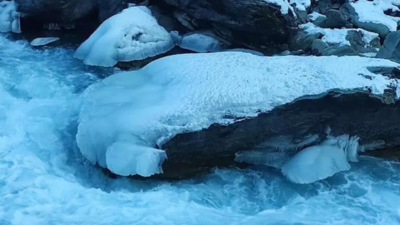- News
- City News
- dehradun News
- Glaciers feeding Ganga, Indus shrinking at alarming rate: Report
Trending
Glaciers feeding Ganga, Indus shrinking at alarming rate: Report
Glaciers feeding key rivers like the Ganga and Indus are shrinking rapidly, threatening the water supply for half of Asia's population. A recent report warns that if emissions remain high, up to 80% of these glaciers could disappear by 2100, with severe socio-economic consequences.
DEHRADUN: A recently released fact sheet, titled ‘Stop the Melt' and published by Hong Kong-based think tank China Water Risk (CWR), warns that glaciers feeding the Ganga, Indus, Brahmaputra and Mekong are shrinking at an alarming rate. By 2050, these rivers could surpass their peak water levels—the highest point their surface reaches before declining as sources dry up.

Asia's water towers in peril
This spells trouble for the 10 Hindu Kush Himalayas (HKH) river basins that sustain half of Asia's population. The Indus and Tarim, which rely heavily on glacial melt, will be hit hardest, exacerbating water shortage in Pakistan, India and China.
"The HKH, also called the Himalayan water towers, serve as the origin for 10 major rivers in Asia, including the Ganga, Indus, Mekong, Yangtze and Yellow rivers," the fact sheet notes. These river basins are home to over 1.9 billion people, support over 280 major cities and 865 GW of power infrastructure, making them vital economic hubs."
Notably, the World Meteorological Organisation (WMO) recently stated in its annual climate report that 2024 was the warmest year in the 175-year observational record, with the global mean temperature reaching 1.55°C above pre-industrial levels.
The CWR report said Asia's natural "ice bank" is shrinking rapidly, with over 14 trillion tonnes of ice lost in the past 30 years—an average of 50 million tonnes per hour from mountain glaciers and polar regions. "Such massive losses have dire consequences, especially in Asia, yet what's happening in our cryosphere remains out of sight and out of mind," said Debra Tan, head of CWR.
Adding to the crisis is shifting monsoon patterns, driven by rising temperatures, which are disrupting traditional weather systems. Experts warn that monsoons will start earlier, last longer and bring more extreme precipitation, leading to prolonged droughts and devastating floods.
Citing the Intergovernmental Panel on Climate Change (IPCC), the report stressed the need to cut greenhouse gas emissions by 43% to keep global temperatures within 1.5°C above pre-industrial levels and slow glacier melt. "We must act to decarbonise fast if we are to preserve our precious glaciers," urged Pema Gyamtsho, director general of International Centre for Integrated Mountain Development (ICIMOD).

About the Author
Gaurav TalwarEnd of Article
FOLLOW US ON SOCIAL MEDIA









